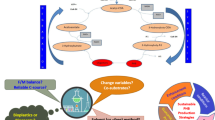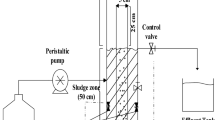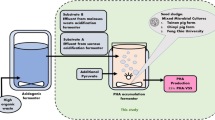Abstract
In order to improve poly-β-hydroxybutyrate (PHB) production in activated sludge, the anaerobic/aerobic alternative operating sequencing batch reactor (SBR) process was applied in this paper to accumulate PHB. Effects of nutritional conditions and carbon concentration on PHB accumulation were studied. Results indicated that PHB accumulation reached the highest level and accounted for 11.2 % under anaerobic condition for phosphate limitation and 20.84 % under aerobic condition for nitrogen and phosphate limitation of mixed liquor suspended solid (MLSS), respectively. In addition, 4 g/L was proved to be the optimum carbon concentration in both anaerobic and aerobic experiments, and the PHB accumulation reached 17.1 % (anaerobic, phosphorus limitation) and 60.4 % (aerobic, nitrogen and phosphorus limitation) of MLSS, respectively. PHB could be successfully extracted with sodium hypochlorite and chloroform method from the activated sludge. In addition, the infrared spectrum showed that the PHB sample extracted was of high purity.
Similar content being viewed by others
References
Castilho L R, Mitchell D A, Freire D M. Production of Polyhydroxyalkanoates (PHAs) from Waste Materials and By-products by Submerged and Solid-state Fermentation[J]. Bioresource Technol., 2009, 100: 5996–6009
Tripathi A D, Srivastava S K, Singh R P. Statistical Optimization of Physical Process Variables for Bio-plastic (PHB) Production by Alcaligenes sp.[J]. Biomass Bioenerg., 2013, 55: 243–250
Fernández-Dacosta C, Posada J A, Kleerebezem R, et al. Microbial Community-based Polyhydroxyalkanoates (PHAs) Production from Wastewater: Techno-economic Analysis and Ex-ante Environmental Assessment[J]. Bioresour. Technol., 2015, 185: 368–377
Kulkarni S O, Kanekar P P, Nilegaonkar S S, et al. Production and Characterization of A Biodegradable Poly (hydroxybutyrate-co-hydroxyvalerate) (PHB-co-PHV) Copolymer by Moderately Haloalkalitolerant Halomonas Campisalis MCM B-1027 Isolated from Lonar Lake, India[J]. Bioresource Technol., 2010, 101(24): 9765–9771
Wang J, Li W W, Yue Z B, et al. Cultivation of Aerobic Granules for PHB Production from Wastewater[J]. Bioresource Technol., 2014, 159: 442–445
Wang B, Sharma-Shivappa R R, Olson J W, et al. Production of PHB (PHB) by Alcaligenes Latus Using Sugarbeet Juice[J]. Ind. Crop Prod., 2013, 43: 802–811
Yu J. Production of PHA from Starchy Waste Water via Organic Acids. J. Biotechnol., 2001, 86: 105–112
Torri C, Cordiani H, Samorì C, et al. Fast Procedure for the Analysis of Poly(hydroxyalkanoates) in Bacterial Cells by Off-line Pyrolysis/gaschromatography with Flame Ionization Detector[J]. J. Chromatogr. A, 2014, 1359: 230–236
Patwardhan P R, Srivastava A K. Model-based Fed-batch Cultivation of R. Eutropha for Enhanced Biopolymer Production[J]. Biochem. Eng. J., 2004, 20: 21–28
Xu A, Lao Y, Zhang Q, et al. Extraction and Characterization of PHB from Acidiphilium Cryptum DX1–1[J]. J. Wuhan University of Technology-Mater. Sci. Ed., 2010, 25(6): 938–943
Cheng X, Xiang H, Ye W, et al. Effect of Coated PHB on Properties of Abradable Seal Coating[J]. J. Wuhan University of Technology-Mater. Sci. Ed., 2014, 29(3): 417–421
Pan W Y, Perrotta J A, Stipanovic A J, et al. Production of Polyhydroxyalkanoates by Burkholderia Cepacia ATCC 17759 Using A Detoxified Sugar Maple Hemicellulosic Hydrolysate[J]. J. Ind. Microbiol. Biot., 2012, 39: 459–469
Liu Z, Wang Y, He N, et al. Optimization of PHB (PHB) Production by Excess Activated Sludge and Microbial Community Analysis[J]. J. Hazard Mater., 2010, 185: 8–16
Chen H, Li X. Effect of Static Magnetic Field on Synthesis of Polyhydroxyalkanoates from Different Short-chain Fatty Acids by Activated Sludge[J]. Bioresource Technol., 2008, 99(13): 5538–5544
Wu G, Rodgers M. Dynamics and Function of Intracellular Carbohydrate in Activated Sludge Performing Enhanced Biological Phosphorus Removal[J]. Biochem. Eng. J., 2010, 49(2): 271–276
Valappil S P, Misra S K, Boccaccini A R, et al. Large-scale Production and Efficient Recovery of PHB with Desirable Material Properties, from the Newly Characterized Bacillus Cereus SPV[J]. J. Biotechnol., 2007, 132(3): 251–258
Kansiz M, Billman H, Mc Naughten D. Quantitative Determination of the Biodegradable Polymer Poly(β-hydroxybutyrate) in A Recombinant Escherichia Coli Strain by Use of Mid Infrared Spectroscopy and Multivariate Statics[J]. Appl. Environ. Microb., 2000, 66: 3415–3422
Author information
Authors and Affiliations
Corresponding author
Additional information
LI Xiaoyan and JIN Zijing equally contributed to this research as co-first authors
Funded by the Fundamental Research Funds for the Central Universities (No.2572014CA23), the National Natural Science Foundation of China (No. 51678120)
Rights and permissions
About this article
Cite this article
Li, X., Jin, Z., Qian, Y. et al. Production of poly-β-hydroxybutyrate by activated sludge in sequencing batch reactor under aerobic conditions. J. Wuhan Univ. Technol.-Mat. Sci. Edit. 32, 733–738 (2017). https://doi.org/10.1007/s11595-017-1660-4
Received:
Accepted:
Published:
Issue Date:
DOI: https://doi.org/10.1007/s11595-017-1660-4




